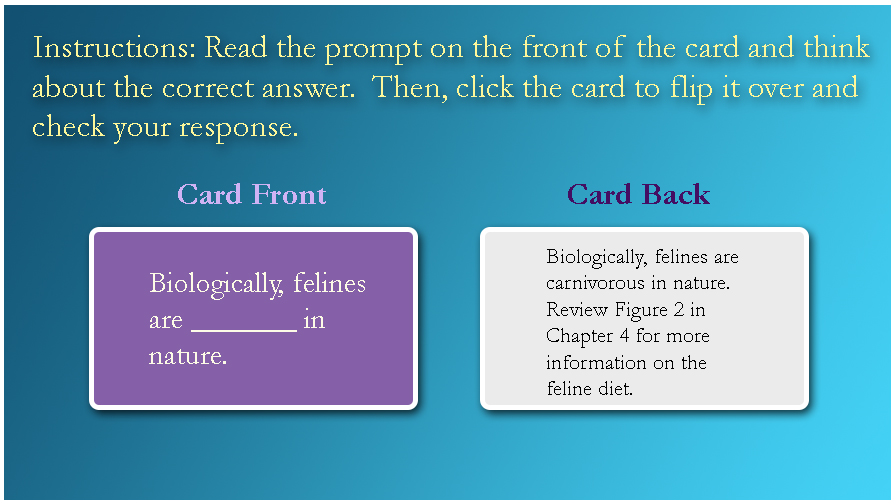Automated Feedback and Interactions/What Kind of Interactives Are There
Automated Feedback and Interactions
[edit | edit source]Click here to return to the main page: Automated Feedback and Interactions
What Kinds of Interactives are There?
[edit | edit source]There are multiple types of interactions in today’s e-learning development world. From the simple multiple choice question to interactive images, depending on the software, the course developer has astounding options compared to years past.
Interactions with Automated Feedback
[edit | edit source]Multiple Choice and Fill-in-the-Blank
[edit | edit source]The multiple choice quiz is likely the most common type of interaction with automated feedback. A series of prompts with multiple answers are presented to the learner, and the learner may select one (or in some cases, more than one) response. It easily serves as a formative assessment strategy.
Example: Multiple Choice
[edit | edit source]
Correct Feedback: Correct! As carnivores, felines feast exclusively on animal flesh.
Incorrect Feedback: Not quite. Review Figure 2 in Chapter 4 for more information on the feline diet.
Fill-in-the-blank exercises can be formatted as above, but some systems allow learners to type the response into the blank. This can be a tedious method because spelling errors and synonyms should be taken into account when determining the correct answer, and most systems limit the possibilities of a correct response. With our carnivore example, the question writer may choose to allow “meat eaters,” “carnivores,” “carnivorous,” “carnevoros,” and other close, correct answers. It is likely impossible to brainstorm all of the ways “carnivorous” can be misspelled.
Example: Fill-in-the-Blank
[edit | edit source]
Correct Feedback: You entered: carnivorous. Correct! As carnivores, felines feast exclusively on animal flesh.
Incorrect Feedback: You entered: karnevorous. Not quite. Review Figure 2 in Chapter 4 for more information on the feline diet.
Matching and Categorization
[edit | edit source]This type of interaction can be configured in many ways (including using a multiple choice format when the system options are limited), but some systems may also allow learners to click and drag items from column to column. One disadvantage to the automated feedback in this interaction is that it’s usually not possible to create individual instances depending upon which responses the learner categorizes - there is either correct or incorrect feedback.
Example: Click-and-Drag
[edit | edit source]
Correct Feedback: Correct! Felines (or cats) are carnivorous, nocturnal creatures. Cervidae (better known as deer) are herbivorous, crepuscular, and ruminants.
Incorrect Feedback: Not quite. Check Chapter 3, Section 2.1 for more information on features of cervidae (deer) and felines (cats).
Flash Card/Card Flip
[edit | edit source]Similar to flashcards manually written on physical notecards, this type of interaction relies on learner honesty. A prompt is displayed on the front of a “card,” which may be a graphic of a notecard or a simple white box. The learner is instructed to think about the prompt, and then click the “card” to display the back, which has the answer. Some programs show an animation when the card flips over.
Example: Card Flip
[edit | edit source]
Quizlet is a popular choice for the flash card style of quizzing and can be embedded in many learning environments.
Knowledge Check
[edit | edit source]Click and submit to choose the correct answers.
